2000s in fashion
.jpg)
2000s fashion is often described as being a global mash up,[1] where trends saw the fusion of previous vintage styles, global and ethnic clothing (e.g. boho), as well as the fashions of numerous music-based subcultures. Hip-hop fashion generally was the most popular among young people of both sexes, followed by the retro inspired indie look later in the decade.
Those 25 years of age and older adopted a dressy casual style which was popular throughout the decade. Globalization also influenced the decade's clothing trends, with the incorporation of Middle Eastern and Asian dress into mainstream European, American and Australasian fashion.[2] Furthermore, eco-friendly and ethical clothing, such as recycled fashions and fake fur, were prominent in the decade.[3]
In the early 2000s, many mid and late 1990s fashions remained fashionable around the globe, while simultaneously introducing newer trends. The later years of the decade saw a large-scale revival of clothing designs primarily from the 1960s, 1970s, and 1980s.
General Trends
High fashion
The leading fashion designers between 2000–09 included the late Alexander McQueen, Vera Wang, Christian Louboutin, Jean-Paul Gaultier, Vivienne Westwood,[4] and Karl Lagerfeld.[5] The top supermodels of the decade were Kate Moss, Gisele Bündchen,[6]Carmen Kass, Adriana Lima, Alessandra Ambrosio, Heidi Klum, Naomi Campbell, Tyra Banks, Karolína Kurková, Miranda Kerr, Izabel Goulart, Selita Ebanks, Christy Turlington, Linda Evangelista, Marisa Miller, Doutzen Kroes, Agyness Deyn, Coco Rocha, Lily Donaldson, Chanel Iman, Sasha Pivovarova, Caroline Trentini, Iselin Steiro, Caroline Winberg, Gemma Ward, Karen Elson, Missy Rayder, Carolyn Murphy, Natalia Vodianova, Liya Kebede, Élise Crombez, Daria Werbowy, Julia Stegner, Lara Stone, Meghan Collison, Catherine McNeil, Lily Cole, Anna Jagodzińska, Isabeli Fontana, Mariacarla Boscono, Erin Wasson and Jessica Stam.[7]
The rise of fast fashion
The early to mid-2000s saw a rise in the consumption of fast fashion: affordable off-the-peg high street clothing based on the latest high fashion designs. With its low cost appeal driven by trends straight off the runway, fast fashion was a significant factor in the fashion industry's growth. As affordable clothing became even more important in the entrance to the new age, brands had to find a way to keep up with their consumer's new spending habits.[8]
During the year 1999, department stores such as Macy’s, J.C. Penney, Kohl’s and more had sales totaling $230 billion. In the years that followed, that number began to fall. By the early 2000s the rise of online retail and in-store fast fashion caused department store sales to dwindle in sales in the wake of new styles being offered quicker than ever before by retailers.[9] Retail giants of the new millennium included H&M, Forever 21, and Zara. Notably, the retailer Target found major success in collaborating with various fashion designers for affordable designer pieces available for the average consumer.[10]
This trend in fast fashion allowed shoppers to own designer items at lower prices, also allowing the acceptance and production of copycat styles.[11] Designers noticed their designs were being knocked-off, and decided to do something about it. In 2004, the retail giant H&M, a master in rolling out fast fashion, collaborated with fashion designer Karl Lagerfield to introduce a one-time collection which proved to be a huge success, as women flocked to H&M stores to own a piece of the designer's 30 selections available in the collection.[12]
Stores such as Wet Seal and American Apparel are said to be “American precursors to the fast fashion empire”.[8] As well as the retail stores Hollister, Abercrombie & Fitch and possibly on a much smaller scale Limited Too, but in the end, stores like Forever 21 were better able to stay on top of the retail game.
Ethics
The ethics of fast fashion has been the topic of numerous debates and questioning of business practices. Producing fashion at such fast rates involves less than secure worker conditions, and non-livable wages for the laborers. It also involves a lot of waste. Americans throw out 14 million tons of clothing a year, with the help of fast fashion.[13] Retailers like Forever 21 and H&M have come under fire, not only for their wasteful fast fashion practices that have grown steadily since the beginning of 2000, but for the involvement of cheap labor. The appeal of fast fashion lies in the copying of higher end brands; however, after something is no longer trendy it is on to the next, leaving clothes to go to waste, and workers to continue to live on unlivable wages.[14]
Socioeconomics and the logo purse
The 2000s saw social classes broken down and restructured so specifically that they became meaningless, and anyone could transcend the typical stereotypes of class with what they owned.[15] In high fashion, there was less of a top-down approach to fashion, and designers were becoming increasingly inspired by pop culture and street style. These two factors combined led to the popularity of the designer logo that was seen boldly printed on all types of clothing, but specifically purses. A logo purse was a unifier, worn by celebrities, models, and the middle-class shopper. Many of these brands had outlet stores, so the logo purse was available to even more people. Having the same branded purse as many others was a form of escapism, it was a unifying factor that let people forget how much money they made, and instead focus on being like the rest.[15]
The rise of fast fashion helped people afford a designer bag, since they could save money on the rest of their wardrobe. As the decade went on, it became increasingly popular to mix designer and fast fashion clothing. People were more concerned with looking the part and fitting into a certain style tribe than who was making the clothes.[16]
Women's fashion
Early 2000s (2000–03)
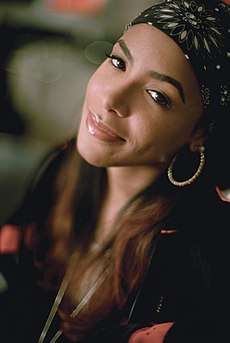
Y2K fashion
- When the 2000s kicked off, the fashion was profoundly influenced by technology. From 1997 until 2001, there was a monochromatic futuristic approach to fashion,[17] with metallics, shiny blacks, heavy use of gray, straps, and buckles becoming commonplace. This was called "Y2K fashion". The apparel was made to be as dark, reflective, technological, and as sexy as possible. When the original iPod was introduced in 2001, the earbuds, as well as the gadget itself, became something of an accessory for early adopters.[18]
- Particular pieces of Y2K clothing included mesh tops, wraparound sunglasses, wireframe rectangle glasses, box-pleated skirts, handkerchief tops (often in a metallic pattern such as silver or gold for a disco feel),[19] satin skirts, leather skirts,[20] concert t-shirts with rhinestones,[17] sparkling shoes,[21] halter tops, sequinned pants (popularized by Peter Morrissey),[22] and embroidered and sequinned tops (inspired by Easton Pearson),[22][23] along with the famous pearl printed black cocktail dress by Karen Walker, which was successful worldwide.[22]
- In the year 2000, some of the casual women's and girl's fashion trends were oversized sunglasses,[24] aviator sunglasses,[22] oversized hoop earrings,[17] jeans worn for numerous occasions[24] (such as mid-rise, boot-cut, fabric accents down the sides, fabric accents sewn into the flares, lace-up sides and tie-dye[21]), wedge flip flops,[24] hot pants,[21] denim jackets, chunky sweaters, pashmina scarves,[20] Skechers,[25] belly shirts, and tube tops.
Casual chic
- In Europe, North America, East Asia, South America, and Oceania, the early 2000s saw the continuation of many mid and late 1990s fashions due to the continued influence of teen pop stars such as Britney Spears and Christina Aguilera, such as the military look,[26] while introducing newer more vaguely dystopian post modern trends. From 2001 onwards, women wore long-sleeved shirts with bell sleeves, cowl-neck tops, crop tops, Burberry, hoodies, flare jeans, hip-huggers,[27] low rise pants,[26][28] white jeans,[29] whale tails,[30] cargo pants[31][32] (especially ones made out of silk, satin, and velvet)[33][34] hip-hop inspired sweatpants, daisy dukes, thong underwear, and solid bright-colored tights.[34]
- 9/11 and the mortgage crisis of 2001 impacted fashion by bringing in a new wave of conservatism. This created a rise in denim, the American fabric of the working person. Jeans became acceptable in every situation, from the supermarket to the red carpet.[35] It was a slow shift to conservatism, seen in how jeans started low-rise in reflection of the sexy Y2K style and moved through various waistlines and leg widths. As mentioned with the social classes, logos became a form of stability and comfort in fashion. There was a sense of unity in the country because all kinds of people were buying the same brands and sporting the same logos.[35]
- Perhaps in reaction to the streamlined, futuristic, outer space-themed Y2K styles of the year 2000, distressed denim became popular in America from 2001–08. Pants became lower waisted and significantly more flared than they were previously, and often featured elaborate embroidery rather than the utilitarian, no-frills style of before.[18] In the UK, it was popular for women to wear skirts over trousers, floral print shift dresses, and colors like black, purple and pink. Big, chunky shoes and sandals were popular, with thick wedge heels and imitation leather straps decorated with floral embroidery, while previously successful sneaker brands like Sketchers declined in popularity.[25]
First-wave 1980s revival
- Although the 1980s fashion revival was not in full swing until 2001, the first movement had started in the late 1990s and continued into the early 2000s. This first wave primarily focused on the early 1980s. Such trends that emerged during this period included denim miniskirts, ripped "distressed" jeans, denim jackets, tracksuits,[32] trenchcoats (often in pleather), puffy jackets (revived by Hip-Hop artists), and preppy polo shirts with popped collars. These remained popular until about 2008 when the revival of late 1980s fashions occurred.
- Overall, European and American women and girls wore low-top sneakers, such as Skechers, Heelys, Adidas shoes, Reebok shoes, and Nike, as well as knee-high boots with spiked heels and pointed toes (or conversely, thick low heels and round or square toes).[26] Popular accessories of the early 2000s include white belts, aviator sunglasses, trucker hats, hoop earrings, block heeled mary janes,[34] leg warmers (worn with mini skirts),[34][36] ugg boots,[30] flip-flops, jelly shoes,[37] lace-up sandals,[29] newsboy caps, ponchos, and jelly bracelets.[38]
Sex and the City
Sex and the City impacted how women cared about fashion and how they shopped. The show depicted women as empowered consumers, each with their own independent styles that shopped based on what they wanted, not what they were told to wear.[39] The main characters became fashion icons, inspiring window displays, fashion lines, magazines, and women globally. Carrie Bradshaw, the main character, is credited for making Manolo Blahnik a household name from her obsession with the shoes.[40] Trends inspired by the show include stilettos, designer handbags (with two episodes centered around the latest It bag), large fabric flowers, and berets.[41]
Mid 2000s (2004–06)
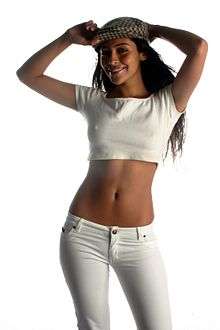
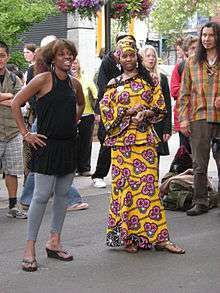
It items and 1960s revival
- It items were very popular in the 2000s, particularly the early and middle years. Examples of some highly sought-after It items of the mid 2000s included Kate Spade wallets, Prada sneakers, Christian Dior saddle bags, designer-brand jeans such as True Religion low-rise boot-cut jeans and 7 for all Mankind skinny jeans, Juicy Couture velour tracksuits, Balenciaga cargo pants, Von Dutch trucker hats, and Takashi Murakami's collaboration with Louis Vuitton for their iconic It bag.[42]
- Popular mid 2000s trends for women were embroidered low-rise jeans, yoga pants, thong underwear, cowl-neck tops, tube tops, denim jackets, bell-sleeved shirts, jean shorts, crop tops, whale tails, tracksuits,[30] cargo pants, capri pants, trenchcoats, puffy jackets, longer tank tops worn with a main blouse or shirt, infantile dresses,[30] 1940s inspired New Look dresses and sandals,[43] leggings, 1960s style peacoats, tunics[44] worn with wide[45] or thin belts, and "vintage clothing" including hippie and Boho inspired dresses with paisley patterns. Crocs were a brief fad for both sexes in the summer of 2006, despite their kitsch connotations,[46][47][48] and in 2006 the minidress made a comeback with the hemlines being unusually short.[49]
- Introduced in 2005, skinny jeans became popular in 2006.[50][51] High heeled shoes were replaced with ballet flats, Sperry Top-Siders, Converse Chucks, and the Keds popularized by Mischa Barton.
- Popular accessories included trucker hats,[30] aviator sunglasses, small red glass or pearl drop earrings rather than the large hoop earrings of the early 2000s, jelly bracelets, knee-high boots with pointed toes, uggs,[30] Heelys, platform boots,[52] ballet flats,[53] mary janes, studded belts, shutter shades, crucifixes and rosaries, large silver belt buckles with rhinestones, black nail polish,[54] fairtrade African bangles, Native American beaded jewellery,[55] Indian and Middle Eastern slave bracelets, purity rings, small leather handbags, small scarves,[56] and simple jewellery made from recycled eco friendly materials like hemp, wood, sea shells, glass, seeds, and white metal.
Military influences
- From 2005 until the end of the decade, more elaborate military inspired clothing became a unisex[57] trend in Britain. Due to the popularity of the Pirates of the Caribbean films, and a resurgence of interest in 1980s fashion, teen and college age women frequently wore cavalier boots,[58] Greek fisherman's caps, jewelry with anchor motifs, leather look drainpipe trousers, frilly satin poet shirts, sashes, harem pants, braided hussar jackets, and dress uniforms with epaulets inspired by female pop stars, British indie/garage rock band The Libertines and MCR's The Black Parade.[59]
African clothing
- Throughout the mid and late 2000s,[60] women's clothing in Africa comprised either brightly colored kente cloth or mudcloth traditional dress such as the boubou, pagne, and doek, or secondhand Western dress donated and distributed by British and American charities.[61] Mitumba clothing had been imported into Tanzania[62] and Kenya since the economic liberalisation of the early 1990s,[63] and was more desirable than newly made Chinese textiles due to its higher quality of construction and recognisable brand labels.[64]
Late 2000s (2007–09)
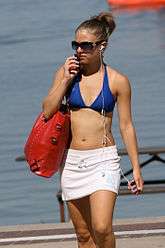
Carry over styles
- Many early and mid 2000s fashions remained fashionable in 2007; This included items such as denim miniskirts, whale tail, hip-huggers, boot-cut jeans, tank-tops, ripped jeans, hoodies, cargo pants, white belts, cropped jackets, capris, infantile dresses, boho-chic, and Crocs.[30]
Second wave 1980s revival
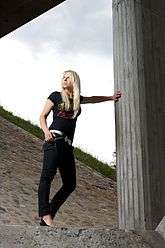
- In early 2009, there was a large scale 1980s revival in Europe and the US, which incorporated general items of late 1980s and early 1990s streetwear, such as neon colors, gladiator sandals,[30] animal print or polka dot headbands, knitted sweater dresses, Nike Tempo shorts, wonderbra and sloggi underwear, sundresses, geometric pattern tops, slap bracelets, ballet flats, black spandex leggings, pale denim jeggings, light, translucent tartan shirts worn with a camisole underneath, kinky boots, riding boots, ripped acid wash skinny jeans, and neon leg warmers worn with bare legs and a dress or skirt.[30] In America, the crop tops that exposed the navel were replaced with longer camisole tops, boat neck blouses and mid rise pants, and miniskirts were replaced with longer dresses like the babydoll, bubble skirt, skater dress, and sweater dress. Long, baggy empire line shirts were taken in at the bustline and often paired with a belt. Fur coats made a comeback, although many women used "fish fur" due to real fur's association with animal cruelty.[65]
- The canary yellow dress Reese Witherspoon wore to the Golden Globes helped establish that hue as a signature color in 2007.[66]
Eastern and fairtrade fashion
.jpg)
- Summer 2007 saw a resurgence of interest in ethnic fashion from India[67][68] and the Middle East, including harem pants, embroidered kurti, silk sashes, sarongs, gypsy tops, and the saree[69][70][71] as young British and American women discovered Bollywood cinema[72] and belly dancing, popularized by Shakira.[73]
- In Britain and the US, some younger women and teen girls, especially those affiliated with the scene subculture and geek chic, became influenced by Japanese street fashion due to the media coverage of Japanese popular culture and J-pop music from 2005-09.[74] Although a small minority wore anime or manga inspired sailor dresses, kawaii[75] or full gothic lolita outfits, most incorporated a single garment such as striped neon knee socks, petticoats,[76] rainbow dresses, knitted leg warmers, hair bows, silk floral kimono pajamas,[77] unisex brands like A Bathing Ape,[78] and cupcake, cherry or Hello Kitty[79] jewellery for an ageless, child or doll-like appearance.
Activist chic
- In Britain and Australia, Middle Eastern shemaghs were worn as scarves as a protest against the Iraq War and demonstration of solidarity with the Palestinians.[80]
- In 2007, Che Guevara chic was popular in Europe and Latin America, with olive green fatigue jackets, boonie hats, berets, and T-shirts featuring red stars or the face of the famous revolutionary.[81]
Men's fashion
Early 2000s (2000–03)
Y2K fashion
- At the very beginning of the decade, the excitement of entering the new millennium had become evident in fashion in the first couple of years, although this was only prominent in nightclub and "going out" attire. Clothing was mostly made in black, though silver was also fashionable.[18] An example of this would be a tracksuit,[19] Rockport boots, a dress shirt, a pair of pants, a camp shirt, or a jacket in a fancy metallic pattern for going out; while also compromising of items such as leather coats and pants, puffy vests and jackets, ribbed sweaters and shirts, and chunky dress shoes, usually in futuristic colors such as black, silver, light gray, and white.[82][83] It lasted from late 1999[82] until late 2001.[18]
Leisurewear
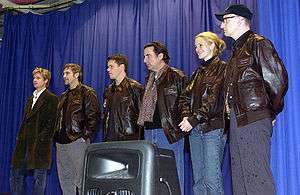
- After the events of 9/11, fashion became more conservative, forgoing the futuristic styles of before. Distressed denim made a comeback, with sandblasted highlights, frosted jeans, ripped jeans, and whiskering becoming commonplace. A lower rise jean had emerged during this part of the decade, effectively getting rid of the high-waisted styles of the 1990s.[28]
- Generally, many fashion trends from 1995 onwards continued to be worn in the early years of the decade. Newer fashion trends in the early 2000s included wearing sportswear and military wear[26] as everyday clothes. This included tracksuits,[32][84] light-colored polo shirts[85] (sometimes striped and with collars popped), cargo pants[31][32][86] (even ones made out of linen during warmer months),[87] khaki chinos, bootcut jeans, corduroy pants,[88] and rugby shirts.[89] Practical hiking jackets (of the type made by Berghaus), fleeces, puffer jackets, and padded tartan lumberjack-type shirts were worn as winter outerwear[89] along with brown, grey, burgundy, rust, maroon, or forest green turtleneck sweaters,[90] and odd navy blue, stone grey, beige, or natural linen sportcoats that fastened with three buttons.[89] These fashions continued into the mid and late 2000s.
- Men's Accessories of the early 2000s included white belts, Aviator sunglasses, trucker hats,[34] flip-flops, oxford shoes, argyle socks (usually worn over tracksuit bottoms), Rockport boots, sneakers from brands such as Nike, Adidas, and Puma, baseball caps (bearing the logos of football, soccer, basketball, and baseball teams),[91] and jelly bracelets.[38]
Asian fashions
- From 2001 onwards, Astrakhan caps, kufis and the pakol[92] were fashionable among Muslim men in Afghanistan, Pakistan, France and Italy.[93] In India, traditional rustic male attire such as the dhoti and Lungi declined in popularity among the younger generation in favor of Westernised fashions such as Levi Strauss or Arvind Mills jeans,[94][95] cargo pants, shorts, tracksuits,[96] and sneakers.
Mid 2000s (2004–06)
1960s revival

- In the mid 2000s, retro fashions inspired by British indie pop, garage rock revivalist groups, and the 1960s mod culture gained mainstream popularity.[97] From 2004 to 2006, common items of clothing in the US and Europe included bootcut jeans with a light wash, wide-leg pants, cargo pants, cargo shorts, camp shirts with elaborate designs,[98] vintage Classic rock T-shirts, throwback uniforms, T-shirts bearing retro pre-1980 advertisements or street art,[99] army surplus dress uniforms, paisley shirts,[100] Mod-style velvet sportcoats, parkas, windbreakers[101] Harris tweed jackets, and fitted 1970s-style Western shirts[102] with pearl snaps[103] (popularised by blues-rock band the White Stripes).
Retro movie inspirations
- In 2004, men's fashion was inspired by movies from the 1960s and 1980s. Of particular inspiration were the movies Top Gun, Bullitt, and Midnight Cowboy. The clothes which were derived from these movies included Henley shirts, muscle shirts, hoodies, cargo pants,[104] American football shirts, aviator jackets, cable-knit sweaters, khakis, seersucker suits,[105] western shirts, blazers, and peacoats.[106]
- Popular men's accessories of the mid 2000s included black brogue shoes,[107] square-toed Steve Madden ankle boots, Adidas sneakers,[108] loafers, casual shoes, Oxford dress shoes,[109] Converse All Stars, winklepickers (taken to extremes by individuals within the Mexican cholo and lowrider subcultures), flip-flops,[98] chokers, puka shell necklaces, shell bracelets, hemp jewelry, charity bracelets, trucker hats, and earrings.
Business suits
- In the UK workplace, black, navy or charcoal pinstripe three-buttoned office suits remained common, but Nehru suits[110] or mandarin collar shirts[111] inspired by the Beatles, James Bond, and science fiction movies like the Matrix, were a popular alternative from 2003–06. In the US, men favored the smart casual look, with striped purple dress shirts,[112] flat front charcoal chinos,[113] beige cardigans,[114] Argyll pullovers, black or brown leather blazers,[115] and houndstooth sportcoats.[116]
Late 2000s (2007–09)
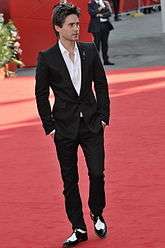
Throwback fashions
- In the late 2000s, 1950s[117] and 1980s fashions became popular: Letterman jackets, black leather jackets[118] like the Perfecto, windbreakers,[119] dashiki[120] or Hawaiian shirts,[121] ski jackets,[122] slim and straight leg jeans,[123] wool topcoats,[124] Ed Hardy T-shirts with low necklines, neon colors inspired by the rave scene,[125] roll sleeve tartan flannel shirts worn with white T-shirts, cardigans and knitted V-neck sweaters.[126]
- In the late 2000s, common accessories worn by men included retro Patek Philippe, Casio G-Shock[127] and Rolex wristwatches, Ray Ban Wayfarers and Aviator sunglasses,[128] and geek chic inspired horn rimmed glasses. Desirable footwear in Europe and America included Sperry Top-Siders, Keds, motorcycle boots, Nike Air Jordans,[129] checkerboard pattern Vans, and Converse All-Stars.[130]
Ed Hardy

- Due to the mainstream acceptance of body modification, T shirts, baseball caps and hoodies featuring vintage tattoo designs[131] were desirable items in the US, Britain and India, where they were worn with black leather jackets, oversized belt buckles, gold chains, and dark slim-fit jeans by celebrity trendsetters such as Jon Gosselin[132] or the cast of Jersey Shore.[133] V-neck T shirts and graphic printed hoodies became popular among younger British men, in contrast to the designer brands with prominent logos previously worn by the chav subculture. Ed Hardy T-shirts, often embellished with rhinestones, were fashionable from late 2008 until the mid-2010s, when they fell out of favour due to their unintended popularity[134] among young clubgoers stereotyped for being thugs, jocks or guidos.[135]
Slim-fit suits
- In the European workplace, the cut of suits changed, as the three buttoned jackets popular in the 1990s were replaced with 1950s inspired suits comprising a two-buttoned blazer and matching trousers[136] while in the US the power suit made a comeback.[137] Single-breasted European suits sometimes featured contrasting Edwardian style piping on the lapels and were often worn with slim ties and waistcoats.[138]
Youth fashion
Youth fashion was strongly influenced by many music-based subcultures such as emo, indie kids, scene kids,[139] psychobilly, preppy, skater, goth, nu metal (known as moshers in the UK),[140] ravers and hip hop,[141] including the British chav, US gangsta rapper and Mexican Cholo styles of the early 2000s.[142]
- Hip hop
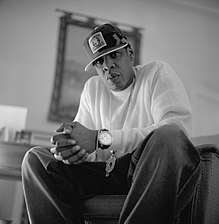
- The clothing of American hip hop fans underwent an evolution from the sagging baggy gangster jeans of the late 1990s to a more retro look by the end of the decade.[143] Popular items of clothing included wide leg jeans, baseball jackets, Nike Air Jordans, tracksuits, sweatpants, bucket hats, stunna shades, fur-lined puffer jackets, and flat-brim trucker hats or baseball caps (often retaining the store label).[144]
- During the early 2000s, many wealthy white jocks and preppies imitated the gangsta lifestyle, eschewing the semi-formal conservative look of the 1980s and 90s in favor of gold bling, expensive designer clothes, sneakers, dark jeans, and sweatpants.[145] Rich girls who dressed this way were known as Queen Bees, plastics, or airheads,[146] and believed their designer clothing was key to being popular.[147]
- Another common American subculture were the cholos and chicanos who wore baggy khaki slacks, gold chains, white T-shirts, and slicked back hair or shaved heads in imitation of Mexican prison gangs.[142]
- Chavs and moshers
- In the early 2000s, the most common British subcultures were the chavs and skate punks who had a (sometimes violent) rivalry.[148] Chavs favored hip hop fashions like tracksuits, burberry baseball caps, white Nike or Adidas trainers, and cheap sportswear made by Reebok or Puma. Common haircuts included spiky hair, a fauxhawk, a heavily gelled quiff, or (for girls) a Croydon facelift.[149]
- The skaters (nicknamed grebos or moshers) had long hair or dreadlocks and wore grunge inspired padded flannel overshirts and baggy pants as these were less likely to rip when skateboarding.[150] Popular clothing included No Fear T-shirts, webbing belts, army surplus patrol caps, band T shirts, dog tags, shark tooth necklaces, camouflage cargo pants, carpenter jeans,[151] tuques, and fingerless gloves in dark colors like black, olive drab, burgundy, and navy blue.[152] From 2001-2007, brands favoured by British skaters and their American counterparts included Quiksilver, Inc., Bape hoodies, Volcom, Element Skateboards, Billabong International Limited, Zoo York Skateboard Company, O'Neill, Bullhead jeans, Vans sneakers, Pacific Sunwear and Journeys.
- Nu metal, rave, and goth
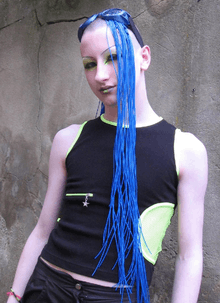
- In America, common subcultures of the early 2000s included the nu metal fans and goths who wore black leather duster coats and tripp pants.
- From the mid-2000s onwards, ravers favored spiky hair and phat pants, while members of the cybergoth[153] and rivethead[154] subcultures opted for shaved heads, synthetic neon dreadlocks, camouflage, tight leather pants, chains, platform boots,[155] stretched body piercings, sleeve tattoos, goggles, corsets, PVC or leather skirts, and black trenchcoats decorated with metal studs.[156]
- Psychobilly and rockabilly
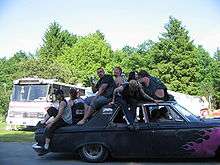
- From the early-mid-2000s, black leather jackets, cowboy boots and Levi's jeans were popular in Scandinavia, Russia and Germany among the hot rod, psychobilly and rockabilly subcultures. Common hairstyles included the quiff, pompadour, and psychobilly mohican.[157]
- Later in the decade, it was popular for women to dress like 1950s pin-up girls in polkadot dresses, pencil skirts, sheath dresses, capri pants, platform heels, 1940s style sandals, retro lingerie like garter belts, stockings, babydolls, petticoats, slips, and corsets, and (real or fake) old school tattoos.[158] This trend, popularised by models like Dita Von Teese, gave rise to the popularity among both sexes of Ed Hardy clothing[159] which lasted from 2007 until 2012.[160]
- Indie and emo
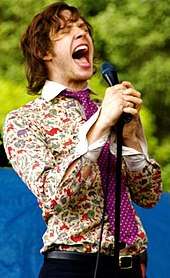
- In 2005, indie pop fashions went mainstream in Europe and North America, prompting a revival of 1960s mod and British Invasion fashions, vintage or thrift store clothing,[161] and the popularization of activist fashions like the keffiyeh.[162] Other subcultures, including American preppies and even rappers like Kanye West, imitated indie fashions[163] or combined them with elements of Japanese street style, like the Harajuku and Lolita fashion popularized by Gwen Stefani.
- The other notable youth group of the mid-2000s were the emo kids, identifiable by their black or purple hoodies, T-shirts featuring rock bands like Fall Out Boy, My Chemical Romance, or Taking Back Sunday. lowrise skinny jeans, snakebites, silver jewellery, and checkerboard pattern Vans. Hair was thin, flat and straight, with long, matte bangs (US) or fringe (UK), usually dyed black.[164]
- Scene kids
- By early 2009 the most conspicuous subculture was the "scene kids."[165][166] They originated in Britain during the late-1990s when some members of the chav subculture began to experiment with alternative fashion,[167] incorporated elements of indie pop, emo,[168] and spread to America and Australia in the mid-2000s.[169] The style, originally comprising tripp pants, stripes, tartan, spiky hair, Chucks, Vans, and trucker hats derived from grunge and skate punk fashion, evolved to incorporate androgynous, matted, flat and straight hair sometimes dyed bright colors, tight jeans,[170] cartoon print hoodies, shutter shades, promise rings,[171] checked shirts, and lots of bright colors.[172] The name was originally derived from "scene queen", a derogatory term within the 1970s glam rock scene for a heterosexual musician who pretended to be gay and later applied to poseurs within the UK goth, heavy metal and punk subcultures.[173] Later, "scene queen" itself was adopted by leading female members of the modern subculture who were unaware of its original meaning, like supermodel Audrey Kitching.[174][175]
2000s beauty trends
Hairstyles
Women
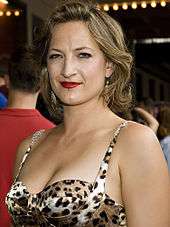
In the early 2000s, women's hair was often long and straight.[176] The early 2000s featured a "zig-zag partings", in which the hairline is parted in a zig-zag fashion. Hair lengths varied from below the earlobes at the shortest to just below the shoulders at the longest.[177] From 1995 until 2008 highlights and lowlights made of blonde, red, and light brown went mainstream. In 2000, highlights were soft and subtle for a sun-kissed look.[177] In 2002 bold and unblended highlights called "chunky highlights" burst onto the scene. This trend was kickstarted by Kelly Clarkson during her time on American Idol, lasting until 2006.[178] The early 2000s also continued the Farrah Fawcett hairstyle revival of the late 1990s.[179] Crimped hair was popular in the early and mid 2000s.
For black women, cornrows, dreadlocks and curly weaves were popular until the late 2000s, when toned-down versions of the Afro, Jheri curl and short pixie cuts were popularized by artists like Janet Jackson and Rihanna. Another popular hairstyle throughout the decade was the braid, rejuvenated by the likes of Alicia Keys and Lauren Conrad. Throughout the early and middle years braids and plaits would often be meticulously put in intricate patterns and would purposely be styled as a way to blend in better with women's clothing styles.[178]
In the mid 2000s, many women favored the bob haircut, as well as its longer version, the long bob or "the lob".[176][178] By 2005, it became unfashionable to center-part one's hair, and the side-swept Bangs of the 1980s made a comeback.
In the late 2000s, dark haired women (and even light-haired ones) favored the jet black hair, as worn by Katy Perry or Amy Winehouse with her trademark beehive hairstyle. Textured hair with volume, natural wavy hair, and the bob cut became popular from 2007 onwards in both Britain and the USA. In 2009, many women sought to imitate the hairstyle Kate Gosselin had that year, briefly bringing back blended highlights into the mainstream. This look ended up only being a fad.[178] Other popular late 2000s trends included Headbands, headwraps and Scrunchies, side ponytails, and braiding on one side of the head.
Men
For European men aged 25–40, shorter hair styles that usually took the form of a quiff were fashionable in the early 2000s, as well as spiked hair and fauxhawks for men aged 18–30. Dark-haired young British men often had dyed-blonde weaves and streaks until the late 2000s when a natural hair color became the norm again.[180] A common haircut among American men and boys was the frosted spiky hair popularized by boybands and pop punk bands from 1996 through 2004. Meanwhile, the crew cut and buzzcut remained popular among balding American and Middle Eastern men from the mid 1990s until the 2010s.
Long, shaggy Mod or surfer hair became popular among many young men between 2003–06 in the UK as many bands moved away from punk rock and rap metal in favor of a 1960s inspired indie or garage rock sound pioneered by groups like The Strokes, Jet, The Killers, The Hives, The Vines, Coldplay, and The White Stripes. These hairstyles gradually replaced the shaggy, grown out curtained hair popular since the late 1990s among American celebrities like Tom Cruise, Jim Adkins of Jimmy Eat World, Alex Band, Jason Wade, Mehmet Okur and Hanno Möttölä.
By the late 2000s, many young British men opted for a clean-cut 1950s inspired hairstyle, kept in place with pomade.[181] Shaved and bald hairstyles along with beards, moustaches, stubble, sideburns, and the goatee became popular in Europe and North America in reaction to the effeminate early and mid 2000s metrosexual look, with charitable events like Movember further increasing their acceptability.[182]
Children and teenagers

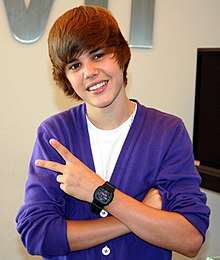
For teenage boys and children, short haircuts such as the quiff, the buzzcut, curtains, crew cut, and Caesar cut were popular in the early 2000s. Girls favored straight hair extensions and chunky highlights. It also became fashionable to sport curly hair with a "zig-zag" side parting and blended highlights around 2002/03.[183] Back in the late 90s and early 2000s, butterfly hair clips and crimped hair became extremely popular for preteens and teenage girls.
In the mid 2000s, longer hair on teenage boys became popular in the UK and America, including the wings haircut, influenced by the 1960s Mod subculture, and British indie pop stars.[184] Hairstyles among teenage girls experienced little change, being largely the same as they were in the early 2000s. Curly hair became less popular in Britain, while straight hair grew more dominant. Highlights remained popular, as well as extensions. Hair was often tied into a ponytail and incorporated long bangs or a fringe.
In 2009, the androgynous Harajuku inspired scene hairstyles (often dyed bright colors) and eyeliner were popular among girls and boys alike: first in Japan, and later in the US and Europe.[185] As an alternative to the scene hairstyles, many teenage girls in the US and Australasia opted for a preppy hairstyle that involved long, straight hair, side-swept and regular bangs and a side part, while boys wore basic skater hair.[186] Many girls wore headbands, headwraps and 80s inspired scrunchies with either a side ponytail or french braid falling over one shoulder.
In between 2006 and 2008, Middle Eastern teenage boys in Australia, namely those of Lebanese descent, acquired the high and tight haircut. Some tend to had the cut with a mullet.
Makeup and cosmetic trends
The year 2000, was based on the glittery Y2K inspired makeup of the late 1990s. With the turn of the millennium, the idea was for women to capture a futuristic, space-age style. With makeup including bronze specks for a metallic shine with ecstatic colors. An alternative for those who did not like metallics was a purple and brown color scheme.[187] Lip gloss was more popular than lipstick among both women and girls.[178] By the spring/summer season of 2001, this look took a backseat in favor of a more low-maintenance, natural style that showed off ones features. However, the glittery looks continued to be popular.[188] In 2002, mineral makeup broke into the mainstream with Bare Minerals, a product of Bare Escentuals. This fueled the trend for natural looking makeup, and became the standard of the 2000s.[178] By 2003, the glittery looks had disappeared.
By around 2005/06, retro-styled makeup from the 1940s had made a comeback, such as bright red lips and cat eyes. In the mid and late 2000s, lip gloss remained popular, and the "Smoky Eye" emerged, with more emphasis on eyeliner, mascara, and eyeshadow.[178] Another emerging trend was a more natural "less is more" approach to makeup around the same time.[189] Also around the second half of the decade, there was an increasing amount of emphasis on the perfection of complexions, with illuminators and shimmer products becoming must-have items.[176] In the late 2000s, there was a craze for fake eyelashes, started by Lady Gaga.[176] This resulted in lash tinting, lash extensions, lash embroidery, and fake lashes. Makeup styles generally became simpler and more individualistic with the rise of How-to YouTube videos.[178]
Body care and grooming
The year 2000 featured natural-colored skin as the most desirable, and did not feature many body care trends other than the rise of hair removal, teeth whitening, and anti-aging creams. In the summer of 2001, the sunless tanning trend broke into the mainstream for both genders,[188] prompted by Jennifer Lopez[176] and Christina Aguilera. This included both self-tanners and spray tans. Cosmetic contacts also became more widespread among both genders this year. In 2002, botox was approved for public use and became hugely popular with women and men. By 2009, fake tanning had gone out of style in favor a pale complexion, inspired by the Twilight film.[178]
The 2000s, continued the unisex trend of bikini waxing which had started in the 1990s.[176] Although waxing in general had been popular among women for several years, it was in the 1990s that complete male body hair removal went mainstream.[190] Being considered suggestive and indecent in the 90s, male waxing became ubiquitous as a result of the metrosexual trend in the early and mid 2000s. Also during this time, it was popular to have a completely clean-shaven face, as if to make one look underage.[178] Male hair removal declined in the late 2000s.
Tattoos and piercings
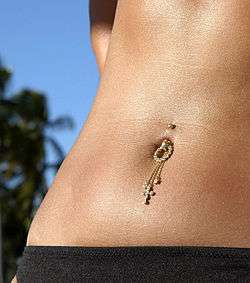
The 2000s, continued the trend of tattoos and piercings among both genders which had begun during the 1990s. Commonplace tattoos in Europe, Australasia, Hong Kong,[191] and North America included tramp stamps and tribal arm tattoos from the early to mid 2000s, and Hindu Sanskrit or Chinese Kanji words from 2007–10.[192][193] Old school tattoos depicting hearts, skulls, flowers or female figures were considered unfashionable[194] and unsophisticated for much of the decade, especially among women. However, these made a comeback in 2008 at the same time Ed Hardy accessories[195][196] and the pin-up girl look were becoming popular.[197]
In the early 2000s, navel piercings reached their peak, as did tongue rings. Other popular piercings throughout the decade include labret piercings, nostril piercings, nipple piercings, and eyebrow piercings. Piercings and tattoos reached the height of their popularity during the mid 2000s[178] but remained a common sight among young people well into the 2010s.
Gallery
A selection of images related to the period.
 Chunky sneakers of the early 2000s.
Chunky sneakers of the early 2000s. Swedish couple in 2002 sporting various early 2000s fashions and hairstyles.
Swedish couple in 2002 sporting various early 2000s fashions and hairstyles. Leeann Tweeden, 2003, wearing an off-the-shoulder top and cargo pants. She also sports highlights on her hair.
Leeann Tweeden, 2003, wearing an off-the-shoulder top and cargo pants. She also sports highlights on her hair. Young woman in 2003 wearing a horizontal striped shirt and boot-cut jeans.
Young woman in 2003 wearing a horizontal striped shirt and boot-cut jeans. German woman wearing jean shorts, popular from 2001–08.
German woman wearing jean shorts, popular from 2001–08.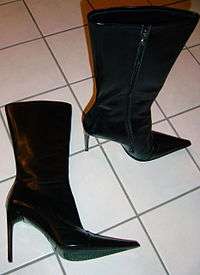 Boots and shoes with pointed toes were popular among both sexes for most of the 2000s.
Boots and shoes with pointed toes were popular among both sexes for most of the 2000s..jpg)
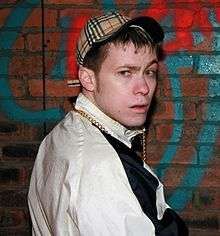
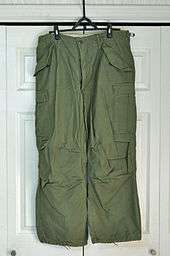 Cargo pants were a unisex trend popular in the early and mid 2000s.
Cargo pants were a unisex trend popular in the early and mid 2000s. Irish youth fashion, early 2000s.
Irish youth fashion, early 2000s. The flared jeans of the late 1990s remained fashionable throughout the early and mid 2000s.
The flared jeans of the late 1990s remained fashionable throughout the early and mid 2000s.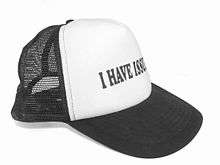 Trucker hats became popular in the early and mid 2000s.
Trucker hats became popular in the early and mid 2000s.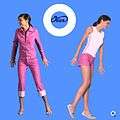 Miranda Kerr in 2004 modeling for Obar Jeans.
Miranda Kerr in 2004 modeling for Obar Jeans.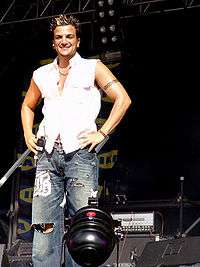 English-Australian singer Peter Andre in 2004 wearing ripped and sandblasted baggy jeans influenced by surfer and hip-hop fashion.
English-Australian singer Peter Andre in 2004 wearing ripped and sandblasted baggy jeans influenced by surfer and hip-hop fashion.- Florida girls dancing on a bar wearing platform boots and animal print outfits.
 Female tourists in 2005 sporting colorful mid 2000s athletic fashions.
Female tourists in 2005 sporting colorful mid 2000s athletic fashions. Bob cut popular among European women from 2003–09.
Bob cut popular among European women from 2003–09. Bright coloured sleeveless dresses, USA, 2009
Bright coloured sleeveless dresses, USA, 2009 Adam Curry, 2005, sporting the shag, popular from 2001–07.
Adam Curry, 2005, sporting the shag, popular from 2001–07. Zooey Deschanel wearing 1960s inspired Boho-chic dress in 2008.
Zooey Deschanel wearing 1960s inspired Boho-chic dress in 2008. Young woman wearing a pink polo shirt, embroidered boot-cut jeans, and white sneakers in 2006.
Young woman wearing a pink polo shirt, embroidered boot-cut jeans, and white sneakers in 2006. Japanese girls wearing Lolita dresses, mid-2000s.
Japanese girls wearing Lolita dresses, mid-2000s. Winklepicker boots fashionable in England, Italy and Mexico from 2005 onwards.
Winklepicker boots fashionable in England, Italy and Mexico from 2005 onwards. Slim-fit tweed jackets have gained in popularity since early 2006.
Slim-fit tweed jackets have gained in popularity since early 2006. Haute couture dress from spring 2006.
Haute couture dress from spring 2006. Girl with curly brown hair sporting an off-the-shoulder top, a carry over from the early 2000s.
Girl with curly brown hair sporting an off-the-shoulder top, a carry over from the early 2000s.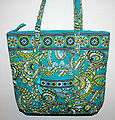 Paisley handbag associated with the boho-chic look.
Paisley handbag associated with the boho-chic look. German Mosher, the more punk-like incarnation of scene, early-mid 2000s.
German Mosher, the more punk-like incarnation of scene, early-mid 2000s. Modern leggings came into fashion in the late 2000s.
Modern leggings came into fashion in the late 2000s.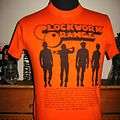 Vintage printed tees worn across Indie, Scene and Nu-Rave fans.
Vintage printed tees worn across Indie, Scene and Nu-Rave fans. Slim-fitting plaid Western shirt gained popularity in the UK from 2008 onwards.
Slim-fitting plaid Western shirt gained popularity in the UK from 2008 onwards. Chinese pop singer wearing vintage military jacket, 2007.
Chinese pop singer wearing vintage military jacket, 2007.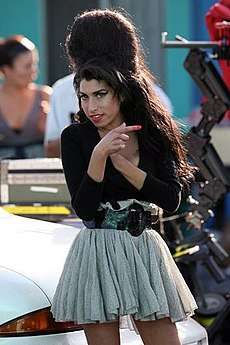 Amy Winehouse with black beehive hairstyle.
Amy Winehouse with black beehive hairstyle.- In late 2008, especially in Italy, the denim waistcoat was a popular feminine fashion accessory.
 Tattoos and extreme body piercings went mainstream in the late 2000s.
Tattoos and extreme body piercings went mainstream in the late 2000s.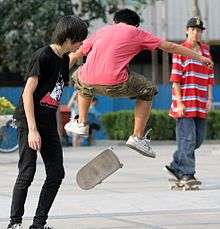 Chinese skaters, 2007.
Chinese skaters, 2007.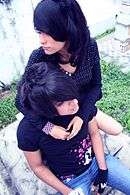 Ecuadorian emo kids from the late 2000s.
Ecuadorian emo kids from the late 2000s..jpg) Young woman wearing sundress and Christian Louboutin shoes, 2009.
Young woman wearing sundress and Christian Louboutin shoes, 2009. Example of the two button slim-fit suit popular from the late 2000s onwards in the UK, US and China.
Example of the two button slim-fit suit popular from the late 2000s onwards in the UK, US and China.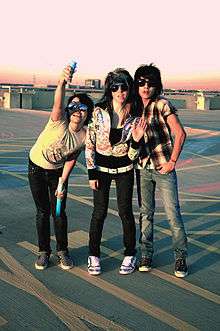 American Scene Kids, 2008.
American Scene Kids, 2008.- Skinny jeans, 2007 to present.[30]
 Woman wearing backless top and microskirt at Cologne Pride, 2006.
Woman wearing backless top and microskirt at Cologne Pride, 2006.
See also
| Wikimedia Commons has media related to 2000s fashion. |
References
- ↑ Rindfuss, Bryan (30 December 2009). "San Antonio Current". Sacurrent.com. Retrieved 30 November 2011.
- ↑ Rindfuss, Bryan (30 December 2009). "Arts: What ought to wear, San Antionio Current". Sacurrent.com. Retrieved 30 November 2011.
- ↑ Rindfuss, Bryan (30 December 2009). "Arts: What ought to wear, San Antonio Current". Sacurrent.com. Retrieved 30 November 2011.
- ↑ Barcelona 2012 Archived 3 September 2011 at the Wayback Machine.. Thebrandery.com.
- ↑ Karl Lagerfeld Interview
- ↑ Forbes Magazine top earning models. Forbes.com (19 July 2007).
- ↑ Vogue's ten covergirls Archived 22 December 2008 at the Wayback Machine.. Style.com (14 September 2012).
- 1 2 Idacavage, Sara (8 June 2016). "Fashion History Lesson: The Origins of Fast Fashion". Fashionista. Retrieved 9 May 2017.
- ↑ Wahba, Phil (21 February 2017). "Can America's Department Stores Survive?". Fortune. Retrieved 9 May 2017.
- ↑ Chernikoff, Leah (12 June 2012). "The Top 20 Designer Collaborations: A Timeline". Fashionista. Retrieved 9 May 2017.
- ↑ Muhlke, Christine (13 October 2010). "Chasing a Fast-Fashion Knockoff". The New York Times. Retrieved 9 May 2017.
- ↑ "Truly Fast Fashion: H&M's Lagerfeld Line Sells Out in Hours". WWD. 15 November 2004. Retrieved 9 May 2017.
- ↑ Wicker, Alden (1 September 2016). "Fast Fashion is Creating an Environmental Crisis". Newsweek. Retrieved 9 May 2017.
- ↑ Chau, Lisa (21 September 2012). "The Wasteful Culture of Forever 21, H&M, and 'Fast Fashion'". US News. Retrieved 9 May 2017.
- 1 2 Lowe, Elizabeth D. Class. doi:10.2752/bewdf/edch3032.
- ↑ Romeo, M (2009). "Television Study: "Gossip Girl" and It's Affects on Viewer's Fashion". The McMaster Journal of Communication. 5: 15–21.
- 1 2 3 "The Year That Was: Style". Entertainment Weekly. 22 December 2000. Retrieved 6 July 2014.
- 1 2 3 4 Brillson, Leila (26 February 2013). "Millennial Trends - Clothing Popular in the 2000s". refinery29.com. Archived from the original on 28 March 2014. Retrieved 26 March 2014.
- 1 2 "Y2K fashion just run-of-the-millenium". Retrieved 5 September 2014.
- 1 2 "Fashion variety the ticket". CNN. 13 October 2000. Retrieved 6 July 2014.
- 1 2 3 "Spring Fashion 2000". Retrieved 6 July 2014.
- 1 2 3 4 "Powerhouse Museum Fashion of the Year 2000". Retrieved 21 June 2014.
- ↑ "Powerhouse Museum – Women's outfit". Retrieved 21 June 2014.
- 1 2 3 "Looking Back at the Best of 2000". collegecandy.com. 14 December 2013. Retrieved 4 May 2014.
- 1 2 "Skechers U.S.A. Inc". Retrieved 3 September 2014.
- 1 2 3 4 "The way we wore: 2002's fashion trends". Seattle Post-Intelligencer. Retrieved 9 May 2014.
- ↑ "Hip Huggers". Retrieved 2 July 2014.
- 1 2 "Millennial Trends - Clothing Popular in the 2000s". refinery29.com. 26 February 2013. Archived from the original on 28 March 2014. Retrieved 27 March 2014.
- 1 2 "All about Spring 2001". Retrieved 21 June 2014.
- 1 2 3 4 5 6 7 8 9 10 "The Short-Lived Trends of the Decade - The 00's Issue - New York Magazine". Retrieved 20 August 2014.
- 1 2 "Lookin' good in cargo pants". Retrieved 9 May 2014.
- 1 2 3 4 "Top 8 Fashion Trends and People of 2003". Retrieved 26 May 2014.
- ↑ "Silky cargo pants all the rage". CNN. 20 February 2003. Retrieved 9 May 2014.
- 1 2 3 4 5 "The Most Okay Fashions of 2003". Retrieved 9 May 2014.
- 1 2 "From Uggs To Y2K, What The '00s Meant To Us | Oye! Times". 2013-02-27. Retrieved 2018-04-20.
- ↑ "Leg Warmers". Retrieved 7 July 2014.
- ↑ Moore, Booth (30 May 2003). "Jammin' jellies". Los Angeles Times.
- 1 2 Mikkelson, Barbara (2003). "Sex Bracelets". snopes.com. Retrieved 8 June 2014.
- ↑ Cunningham, Patricia. Television. doi:10.2752/bewdf/edch3038.
- ↑ Church-Gibson, Pamela; Bruzzi, Stella. Visual Media and Dress. doi:10.2752/bewdf/edch8085.
- ↑ "All of the Trends That Sex and the City Predicted and Perfected". Vogue. Retrieved 2018-04-20.
- ↑ Brillson, Leila (26 February 2013). "Millennial Trends - Clothing Popular in the 2000s". refinery29.com. Archived from the original on 28 March 2014. Retrieved 8 June 2014.
- ↑ Tortora, Phyllis G. and Keith Eubank. Survey of Historic Costume. 4th Edition, 2005. Fairchild Publications.
- ↑ Tell, Caroline (20 December 2006). "Tunic". Time. Retrieved 8 June 2014.
- ↑ Tell, Caroline (20 December 2006). "Wide Belt". Time. Retrieved 8 June 2014.
- ↑ Madden, Mike (27 July 2009). "Admit it – you used to wear Crocs – The Brand Graveyard". Salon.com. Archived from the original on 23 May 2010. Retrieved 31 May 2010.
- ↑ Luscombe, Belinda (10 July 2008). "10 Questions for Tim Gunn". Time. Retrieved 25 June 2010.
- ↑ Oloffson, Kristi (27 May 2010). "The 50 Worst Inventions". Time. Archived from the original on 30 May 2010. Retrieved 31 May 2010.
- ↑ Tell, Caroline (20 December 2006). "Miniskirt and Minidress". Time. Retrieved 26 May 2014.
- ↑ Maxwell, Alison (16 April 2006). "Skinny legs and all: Jeans get slender". USA Today. Retrieved 9 April 2014.
- ↑ Tell, Caroline (20 December 2006). "Skinny Jean". Time. Retrieved 8 June 2014.
- ↑ Tell, Caroline (20 December 2006). "Platform Boot". Time. Retrieved 8 June 2014.
- ↑ Tell, Caroline (20 December 2006). "Ballet Flats". Time. Retrieved 8 June 2014.
- ↑ Tell, Caroline (20 December 2006). "Black Nail Polish". Time. Retrieved 8 June 2014.
- ↑ Contemporary southwestern jewellery. Books.google.co.uk.
- ↑ Tell, Caroline (20 December 2006). "Thomas Wylde". Time. Retrieved 8 June 2014.
- ↑ All dressed up with no war to go
- ↑ "Sonia Rykel". sofeminine.com. Archived from the original on 20 May 2010.
- ↑ Black Parade
- ↑ Driving a hard bargain
- ↑ Mitumba 101
- ↑ Tanzania secondhand economy
- ↑ Global business of secondhand clothes
- ↑ On the road
- ↑ fake or real fur?. Slate.com.
- ↑ "The Best of 2007: Reese Witherspoon". InStyle. Retrieved 3 October 2012.
- ↑ "Deepika always wanted to wear saree at international do". Movies.ndtv.com. Archived from the original on 4 May 2012. Retrieved 13 November 2011.
- ↑ ""Ravan's star-studded premiere in London," ''The Indian Express''". The Indian Express. India. 17 June 2010. Retrieved 13 November 2011.
- ↑ "Saree jahan se achha, ''The Times of India''". Articles.timesofindia.indiatimes.com. 12 September 2008. Retrieved 13 November 2011.
- ↑ "Firang babes in saree-Ashley Judd". indiatimes.com. Archived from the original on 24 December 2010. Retrieved 13 November 2011.
- ↑ "Ashley Judd Is So Very Sari". TMZ. 28 May 2007. Retrieved 13 November 2011.
- ↑ "Around the world in 9 yards". Hindustan Times. India. Archived from the original on 26 December 2011. Retrieved 13 November 2011.
- ↑ PTI (14 May 2010). ""Deepika walks Cannes red carpet in saree," ''The Hindu''". The Hindu. India. Retrieved 13 November 2011.
- ↑ The Guardian
- ↑ AV club
- ↑ Comme des Garcons
- ↑ Fashion sensei, August 2008
- ↑ Shopping rebellion
- ↑ Hello Kitty jewelry Archived 24 August 2011 at the Wayback Machine.
- ↑ "The Last Keffiyeh Factory In Palestine". Palestinemonitor.org. 24 June 2010. Retrieved 30 November 2011.
- ↑ Che chic
- 1 2 "Bloomingdale's I Fall/Winter 1999". Retrieved 4 September 2014.
- ↑ "Bloomingdale's I Fall/Winter 2000". Retrieved 5 September 2014.
- ↑ BBC Inside Out – Charvers Webchat" BBC Retrieved 18 October 2008.
- ↑ 2001 summer fashion. Uk.askmen.com.
- ↑ "The Fashion Of Fall 2003". Retrieved 9 May 2014.
- ↑ "The Styles Of Summer 2003". Retrieved 9 May 2014.
- ↑ Fall 2001 fashion
- 1 2 3 Fall 2001. Uk.askmen.com.
- ↑ Winter style 2002. Uk.askmen.com.
- ↑ Seattle Post Intelligencer. 28 March 2008. Retrieved 25 January 2009
- ↑ Social history of the pakol
- ↑ Karzai's hat
- ↑ Indian consumer purchase behavior
- ↑ When principles pay
- ↑ Global denim
- ↑ "If it's cool, creative and different, it's indie". Edition.cnn.com. 13 October 2006. Retrieved 18 October 2008.
- 1 2 "DKNY Men Summer 2005". Retrieved 8 June 2014.
- ↑ 2004 fall fashion. Uk.askmen.com.
- ↑ Summer 2003 trends. Uk.askmen.com.
- ↑ 2004 trends. Uk.askmen.com.
- ↑ "Ralph Lauren Western shirt". Uk.askmen.com. Retrieved 30 November 2011.
- ↑ Eldor, Karin. "Western shirts, Spring 2005". Uk.askmen.com. Retrieved 30 November 2011.
- ↑ "U.S. Male, Delivered". Retrieved 8 June 2014.
- ↑ "U.S. Male, Delivered". Retrieved 8 June 2014.
- ↑ "U.S. Male, Delivered". Retrieved 8 June 2014.
- ↑ Tell, Caroline (20 December 2006). "Barker Black Brogue Shoe". Time. Retrieved 8 June 2014.
- ↑ "Men's shoes: 5 Trends For Spring 2006". Retrieved 8 June 2014.
- ↑ "Men's shoes: 5 Trends For Spring 2006 (Page 2)". Retrieved 8 June 2014.
- ↑ Nehru Suit on BBC News. Bbc.co.uk (13 January 2012).
- ↑ Summer 2003. Uk.askmen.com.
- ↑ Fall fashions, 2005. Uk.askmen.com.
- ↑ 2004 trends. Uk.askmen.com.
- ↑ Mens fashions, fall 2005. Uk.askmen.com.
- ↑ Leather coats. Uk.askmen.com.
- ↑ Tweed jacket, 2004. Uk.askmen.com.
- ↑ Averill, Farah. "Top 10 hype worthy 2009 fashion trends". Uk.askmen.com. Retrieved 30 November 2011.
- ↑ Averill, Farah. "Jay-Z: Style icon". Uk.askmen.com. Retrieved 30 November 2011.
- ↑ Jackets for fall 2007. Uk.askmen.com.
- ↑ Anyiam, Thony C. (2007), Jumping the Broom in Style, Authorhouse, ISBN 1-4259-8638-2.
- ↑ Mens beachwear
- ↑ Ski jackets, fall 2009. Uk.askmen.com.
- ↑ Dyce, Brandon. "Denim labels you should own". Uk.askmen.com. Retrieved 30 November 2011.
- ↑ Michael A. Lubarsky. "2008 winter overcoats". Uk.askmen.com. Retrieved 30 November 2011.
- ↑ "Bang Face – The Rebirth of Rave, Part One" Rave Talk Retrieved 2008-10-18.
- ↑ Susan Wloszczyna and Ann Oldenburg, USA TODAY. "USATODAY.com – Geek chic" USA Today. Retrieved 2008-10-18.
- ↑ Michael A. Lubarsky. "Throwback writstwatches". Uk.askmen.com. Retrieved 30 November 2011.
- ↑ Dyce, Brandon. "2008 sunglasses". Uk.askmen.com. Retrieved 30 November 2011.
- ↑ "Sneaker Archive". Sneakers.bz. Retrieved 30 November 2011.
- ↑ "Sneaker Files". Sneaker Files. Retrieved 30 November 2011.
- ↑ 11 worst trends
- ↑ Christian Audigier hates Jon Gosselin
- ↑ What not to wear
- ↑ Christian Audigier is a douchebag
- ↑ How men dress their age
- ↑ Averill, Farah. "Two button or three button suit?". Uk.askmen.com. Retrieved 30 November 2011.
- ↑ Averill, Farah. "Power dressing". Uk.askmen.com. Retrieved 30 November 2011.
- ↑ Berger, Jeremy. "Timeless men's lines". Uk.askmen.com. Retrieved 30 November 2011.
- ↑ "The Scene Kid Subculture vs. Emos – News Article" Absolute Punk Retrieved 2008-10-18
- ↑ Moshing and Moshers (8 August 2005) BBC
- ↑ [Keyes, Cheryl. Rap Music and Street Consciousness, p. 152]
- 1 2 Cummings, Laura L. (Autumn 2003). "Cloth-Wrapped People, Trouble, and Power: Pachuco Culture in the Greater Southwest". Journal of the Southwest. 45 (3): 329–348. JSTOR 40170329.
- ↑ Hip hop style. Uk.askmen.com.
- ↑ Wilbekin, Emil. "Great Aspirations: Hip Hop and Fashion Dress for Excess and Success." The Vibe History of Hip Hop. Three Rivers Press 1999. Page 280.
- ↑ Last White Superstar. Web.archive.org (10 January 2010).
- ↑ Meanest high school girls
- ↑ Lists for teens 2002
- ↑ Why is chav still controversial?. Bbc.co.uk (3 June 2011).
- ↑ Croydon facelift. Thesun.co.uk (27 July 2011).
- ↑ Peterson, Brian (2009). Burning Fight: The Nineties Hardcore Revolution in Ethics, Politics, Spirit, and Sound. Revelation Books. ISBN 978-1-889703-02-2.
- ↑ Denim guide. Uk.askmen.com.
- ↑ Ryan Shckler interview. Askmen.com.
- ↑ Dead fashionable. Theage.com.au (13 September 2002).
- ↑ [Lauren M. E. Goodlad, Michael Bibby: Goth. Undead subculture, Duke University Press, 2007, ISBN 978-0-8223-3921-2, p. 47]
- ↑ Rivethead fashion Archived 20 October 2012 at the Wayback Machine.. Voices.yahoo.com.
- ↑ [Baddeley, Gavin (2002). Goth Chic: A Connoisseur's Guide to Dark Culture. London: Plexus Publishing, p. 204.]
- ↑ Raggare comes of age. Guardian.
- ↑ Buszek, Maria Elena (2006). Pin-up grrrls: feminism, sexuality, popular culture. Duke University Press. ISBN 0-8223-3746-0.
- ↑ Ed Hardy shop. Ed Hardy shop.
- ↑ Ed Hardy hat. Uk.askmen.com.
- ↑ Dress like an indie frontman. Uk.askmen.com.
- ↑ Birth of uncool. Guardian.
- ↑ Kanye West. Uk.askmen.com.
- ↑ Grillo, Ioan. (27 March 2008) Emo bashing in Tijuana. Time.com.
- ↑ "Switch". BBC. Retrieved 30 November 2011.
- ↑ "Travis Haight "New Haights: Scene kids ought to receive a crash course on their group" Archived 19 June 2007 at the Wayback Machine. 23 May 2007
- ↑ "The Scene Kid Subculture vs. Emos – News Article". AbsolutePunk.net. 29 March 2008. Retrieved 30 November 2011.
- ↑ Grant Woodward Finding Emos ...and goths, moshers and scene kids Yorkshire Evening Post 9 March 2007
- ↑ Marina Yakhnis "'Scene kids' will destroy democracy" Archived 22 January 2009 at the Wayback Machine. 14 December 2006 The Times-Delphic
- ↑ "Apparel". Hottopic.com. Archived from the original on 1 August 2010. Retrieved 30 November 2011.
- ↑ ^ a b Haenfler, Ross (2006). Straight Edge: Hardcore Punk, Clean Living Youth, and Social Change (p. 11). Piscataway: Rutgers University Press. ISBN 0-8135-3851-3
- ↑ Caroline Marcus "Inside the clash of the teen subcultures" Sydney Morning Herald 30 March 2008
- ↑ Robert Urban, Robert Urban. "Ragged Blade Reviews: Queen's Freddie Mercury and his Legacy" Archived 31 July 2014 at the Wayback Machine. Retrieved 1 August 2010.
- ↑ Audrey Kitching's website. Audrey.buzznet.com.
- ↑ Audrey Kitching: Fashion disaster. Cosmopolitan.com.
- 1 2 3 4 5 6 "Top 10 beauty trends of the '00s". Retrieved 26 July 2014.
- 1 2 "Top Hair Trends For 2000". Retrieved 15 August 2014.
- 1 2 3 4 5 6 7 8 9 10 11 "Beauty Trends of the 2000s". Retrieved 10 April 2014.
- ↑ "Farrah Fawcett Look". Retrieved 17 September 2014.
- ↑ 2000s fashion
- ↑ Old school grooming
- ↑ "Marksimpson.com 'Here come the mirror men' by Mark Simpson – first usage of the word 'metrosexual'" Mark Simpson. Retrieved 18 October 2008.
- ↑ "2002 Hair - Beautiful Hairstyles". Retrieved 5 September 2014.
- ↑ "skater Haircut Retrieved 2008-10-18". Hair-style-salon.org. Retrieved 30 November 2011.
- ↑ "Metropolis – Tokyo feature stories: Face to face with Harajuku – Pictures of Japanese youth" Metropolis.co.jp Retrieved 2008-10-18.
- ↑ rfers_1Julian Wilson
- ↑ "Make-Up For The Year 2000". CBS News. 8 June 1999. Retrieved 25 July 2014.
- 1 2 "COSMETICMALL.COM's SUMMER BEAUTY TRENDS 2001". Retrieved 26 July 2014.
- ↑ "Trends in the Beauty Industry Over the Past 10 Years". Retrieved 26 July 2014.
- ↑ "Waxing For Men". Retrieved 26 July 2014.
- ↑ Hong Kong tribal tattoo
- ↑ Beckham's Chinese tattoo
- ↑ Chinese tattoos popular in West
- ↑ Why do people get tattoos?
- ↑ Ed Hardy phone case
- ↑ Ed's art is booty for digital pirates
- ↑ Tattoos no longer taboo for women